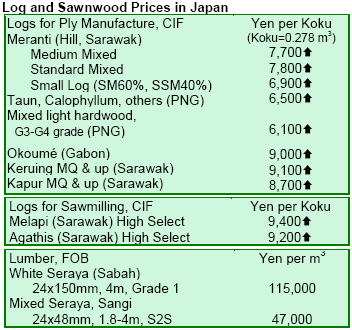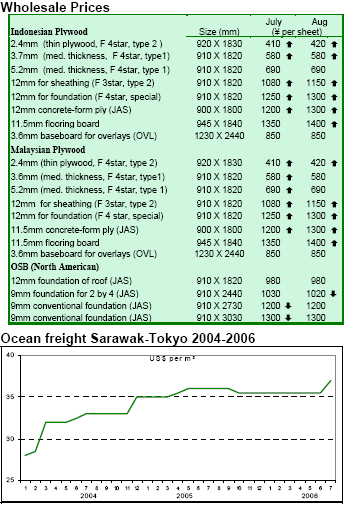|
Japan
Wood Products Prices
Dollar
Exchange Rates of 31th Aug. 2006
Japan
Yen 117.25
Reports
From Japan
Plywood supply and imports decline again
Total volume of plywood supply was 645,000 m3 in June, down 1.8% from May and 3.1% from June last year.
Domestic plywood supply surged 9.2% to 280,000 m3 while imports declined 8.8% to 364,000 m3. By import
source, 192,000 m3 came from Malaysia (down 12.6%)
and 111,000 m3 from Indonesia (down 1.2%). Plywood supply from Indonesia is expected to be stable in
August-September due to a slight improvement of log production in the country since mid-July. Meanwhile,
imports from Malaysia are not expected to increase at least through late October.
Plantation log plywood set to gain ground
In a recent outlook of Japan’s plywood supply, Hideyoshi Kawamura, Head of Itochu Kenzai Corporation’s Wood
Materials Division, predicted that the use of plantation timber for plywood manufacturing would expand in
Indonesia and Malaysia from 2010.
Mr. Kawamura said Indonesia was expected to manufacture 2-2.5 million m³ of plywood in 2006 (down
from 4 million m³ in 2005), of which 50% (about 1.1 million m³) would be exported to Japan (down from 1.85
million m³ in 2005). Out of Indonesia’s 67-68 JAS certified plywood factories, only about 20 factories would
be manufacturing products for Japan. The supply of
Indonesian plywood products to Japan had been rapidly shrinking, particularly 6-12mm plywood. Mr. Kawamura
indicated that Japan’s annual demand for floor base plywood was about 1 million m³. Thus, Indonesian
plywood factories had shifted focus to this product at the expense of concrete-form panels. Mr. Kawamura
suggested the use of substitutes such as softwood plywood to counter the shortage of these panels.
With respect to Malaysia, Mr. Kawamura informed that plywood factories were installing new equipment in spite
of log shortages. He predicted that Malaysia would export to Japan about 2.5 million m³ this year. Malaysia was
expected to begin logging plantation forests in 2010 for
the production of plywood.
Concerning China, Mr. Kawamura predicted the country would export 7-10 million m³ to the world, of which
700,000 m³ would be bound for Japan. China was estimated to have about 500 plywood and 500 board
factories. Most Chinese plywood was targeting the Japanese packing industry, but increasingly more factories
were being JAS certified while quality had been
improving rapidly. Mr. Kawamura believed that the supply of Chinese plywood would continue to grow in Japan and
was set to approach the 1 million m³ level in the near future from just 403,000 m3 in 2005. China’s
competitiveness lies mainly in cheap processing and raw material costs. Poplar logs cost only 900 yuan per m³
($117-120 per m³) while processed boards stand at 1,150
yuan per m³ ($150 per m³). Poplar grows quickly, reaches a diameter of 35 cm in just 5 years and can be logged in
7-8 years.
With regards to Japan’s plywood manufacturing, Mr. Kawamura estimated that lauan plywood production
would be about 900,000 m³ while softwood plywood production would reach 2.4-2.5 million m³ in 2006. He
indicated that thin and medium thick plywood would be eventually substituted by MDF and particle boards within
1-2 years. He also foresaw the substitution of lauan concrete panels by softwood plywood. However, he said
that the supply of softwood raw material from Russia could become unstable due to the heightening of
environmental and nationalist concerns in that country. This and the acute shortage of tropical logs would make
plantation forests the main source of raw materials for the manufacturing of plywood in 3-4 years, according to Mr.
Kawamura. The supply and demand of engineered products such as LVL, compound plywood and OSB
would most likely increase further in Japan in the future.
Seihoku Group acquires Ofunato Plywood
Kita Nihon Plywood of the Seihoku Group bought Ofunato Plywood on 1 August 2006. Ofunato Plywood
manufactured tropical hardwood plywood with thickness of 5.5, 9 and 12mm for the house building sector. Its
monthly production was 80,000 sheets of 12mm 3x6 base. It consumed 2,500-3,000 m3 of logs from Solomon Island
and Sabah, Malaysia and had annual sales of about ¥1 billion. Ofunato Plywood was having difficulties securing
steady supply of tropical logs and facing reduced profitability due to growing costs. Seihoku Group said
Ofunato Plywood would continue manufacturing tropical plywood while undergoing modernization.


|